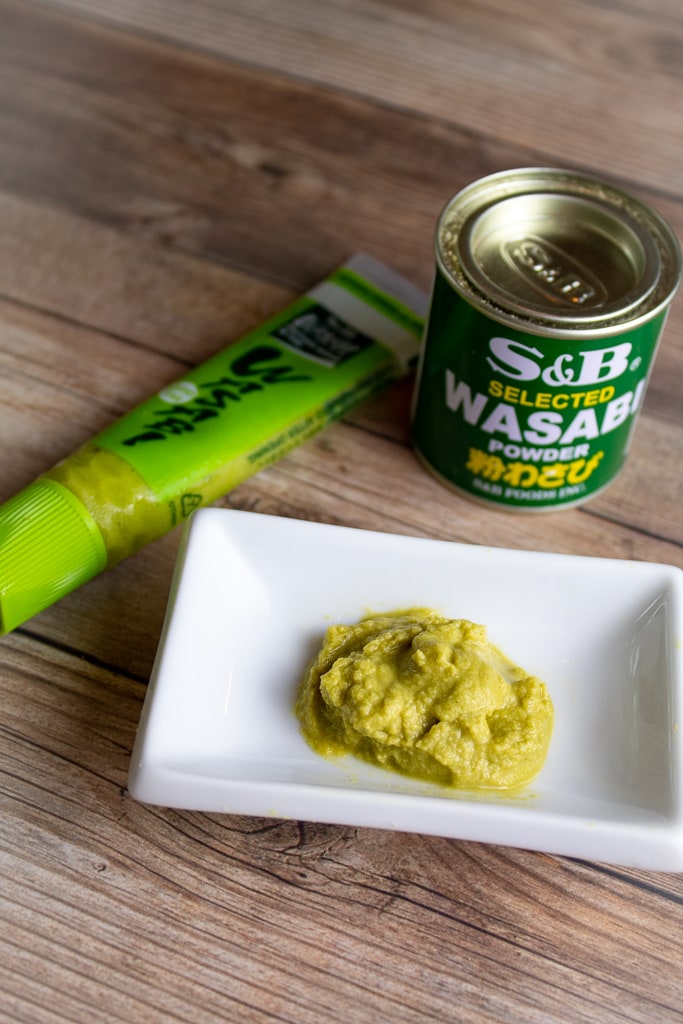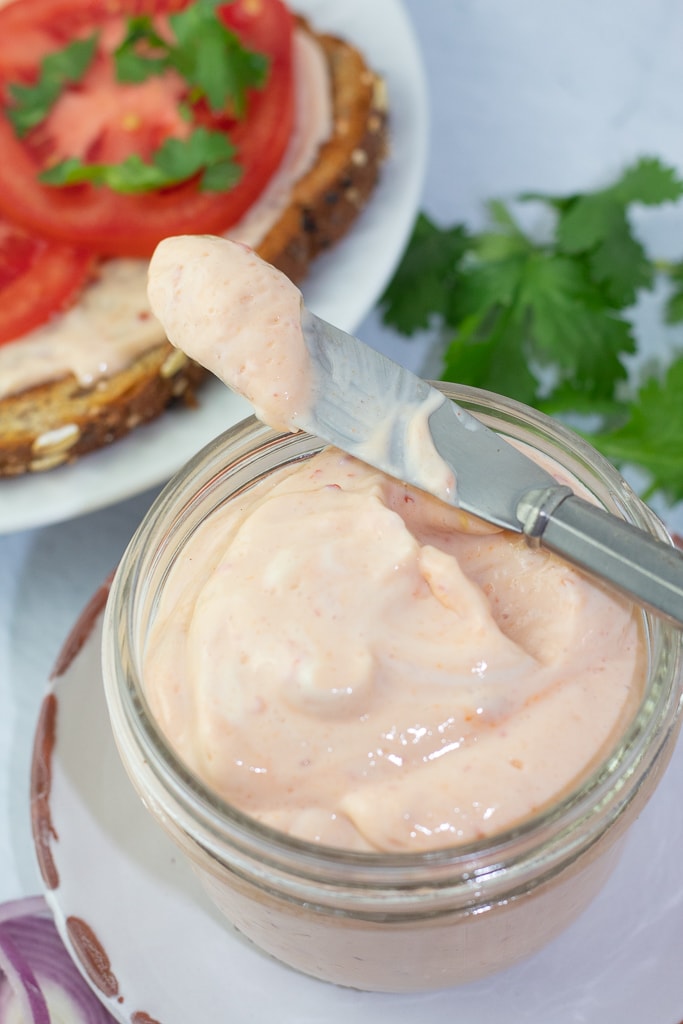Easy Vegan Wasabi Mayo
This vegan wasabi mayonnaise adds a bold, spicy kick to your favorite dishes while staying dairy-free and egg-free. It’s a creamy, plant-based condiment perfect for veggie sushi, sandwiches, burgers, and dips, offering a zesty twist. It is gluten-free, dairy-free, vegan, and oil-free!

Wasabi is definitely an acquired taste, and I know plenty of people who say they absolutely won’t touch it. BUT, I’m betting they have never tried wasabi mayo!
It is much milder than straight-up wasabi. The mayonnaise mellows out the intense sinus-clearing spiciness, leaving you with a subtle and delightful wasabi taste that you can customize to your preferred level of heat!
It makes a delicious dip for veggies or spread for sandwiches or these vegan veggie wraps. It is also delicious in Asian cabbage salad. Believe me, you’re going to love this creamy delicious wasabi mayo!
What is wasabi?
Wasabi, a vibrant green condiment often found accompanying sushi, is a variant of Japanese horseradish that is available either as a ready-made paste in a tube or in a powdered form.
It boasts a distinctive umami taste coupled with an intense, fleeting spiciness. This quick burst of pungent heat makes it an enticing addition, frequently employed on snacks such as peas, crackers, nuts, and chips, contributing to its addictive appeal.
Is wasabi spicy?
Wasabi indeed delivers an initial burst of fiery sensation. It offers a distinct and relatively fleeting type of heat compared to the tongue-blazing intensity of peppers. However, it’s essential to exercise caution and gradually explore your tolerance level with wasabi. Excessive consumption can lead to the sensation of your nasal passages opening wide and, in extreme cases, make you feel as if your hair is about to ignite.
Which is better wasabi powder or paste?

Whether to use the wasabi powder or a paste is an ongoing debate at my house. My daughter, Aya, prefers the pre-made wasabi in the tube because it’s easy to use and she thinks it has a little more zing to it.
I like to use the powder because I think it has a richer flavor and, if I’m being completely honest, it might have a little to do with how much I love the little vintage-looking tin. The powder also has the added convenience of always having it on hand, by storing that cute little tin on a shelf, and then being able to add water and form my own paste whenever I need it.
The powdered form also provides the flexibility to sprinkle it into dishes when you desire an added kick and on nuts and chips to enhance your snack experience. Additionally, it is entirely free of oil. So basically, they’re both great options as far as flavor goes, but one is definitely cuter than the other.
Wasabi tends to mellow over time, and its flavor diminishes, making wasabi mayo spread taste its best on the day of preparation. While it can be refrigerated for up to five days, be aware that the flavor will gradually fade.
Conversely, if you happen to go a bit heavy-handed with the wasabi and fear you’ve ruined a dish, don’t rush to discard it. I once found myself in this situation when I went overboard with wasabi powder while roasting wasabi almonds.
Initially, I thought I had spoiled them, but I couldn’t bring myself to dispose of them. A couple of weeks later, while rummaging through the snack cabinet and feeling adventurous, I decided to give them another try. To my surprise, they were outstanding! The passage of time had mellowed the sharpness, leaving just the right amount of zesty flavor that made them irresistible.
You can find tube and powered wasabi at most Asian grocery stores, online, and in many conventional supermarkets. Keep tube wasabi in the refrigerator after opening. Powdered wasabi is shelf-stable.
How to make wasabi mayo
The recipe card at the bottom of the page has the full list of ingredients with measurements and instructions.

STEP #1: If you’re using wasabi powder, mix the powder and cold water in a bowl. Whisk it into a paste and let it rest for 5 minutes or so while you’re making the vegan mayonnaise.

STEP #2: Open the tofu container and drain the water. Next, place it in a tofu press or on paper towels for 10-15 minutes.
If you’re using shelf-stable tofu which doesn’t need refrigeration (and my preference), you won’t need to press it. However, the refrigerator-type tofu will need to be drained and pressed. This article, Easy Tofu Recipes, has more information on the different types of tofu and how to use them.

STEP #3: Next, put all the mayo ingredients (not the wasabi paste) in a blender and blend until smooth. Pour one cup of it into a bowl.
The mayonnaise will make more than needed for this recipe, so be sure to try it on sandwiches, wraps, and in other vegan recipes.

STEP #4: Add the wasabi paste, ginger, sugar, and salt to the mayo. I recommend starting with a tablespoon of wasabi paste mixed with a cup of mayonnaise.
You can increase the amount, ½ teaspoon at a time until you are satisfied with the heat and flavor.
STEP #5: Keep wasabi mayo in the fridge and let it chill until you are ready to serve. It is best served chilled and does not freeze well.
Recipes to serve with wasabi mayo
It’s versatile! Use it as a spread on sandwiches and wraps, a dip for fries or veggies, or a zesty topping for sushi and grain bowls. Whether used as a dip or spread, this mayo adds a zesty, creamy kick to each bite.
Frequently Asked Questions
Firm or extra firm silken tofu from a shelf-stable box, or the softest refrigerated tofu, are ideal for creams and sauces because they blend into the smoothest, creamiest texture. These types of tofu offer the perfect consistency for making velvety vegan dressings and dips.
Yes, the wasabi in the mayo gives it a bold, spicy kick. You can adjust the level of heat by adding more or less wasabi to suit your taste.
Yes. Store-bought mayonnaise will work, but it is higher in fat and calories.
It should last for approximately 7-10 days in an airtight container in the refrigerator.

We have a whole list of vegan mayo recipes for you to try.
For those of you new to the whole food plant-based lifestyle, we’ve created a FREE 7-Day Plant-Based Menu Planner to help you get started!
If you try this recipe, please let us know how you like it by rating it and leaving a comment. We love to hear from you!
Want to Save This Recipe?
Enter your email & I’ll send it to your inbox. Plus, get great new recipes from me every week!
By submitting this form, you consent to receive emails from EatPlant-Based

Easy Wasabi Mayo
Ingredients
Plain Mayo Ingredients
- 1 13-14 oz block silken firm tofu see notes
- 1 tablespoon dijon mustard
- 1 tablespoon sweetener pure cane, sucanat, maple syrup
- 1 tablespoon red wine vinegar or lemon juice
- 1/4 teaspoon sea salt
Wasabi Mayo
- 1 cup vegan mayo homemade recipe included
- 1 tablespoon wasabi powder
- 1 teaspoon water
- 1/2 teaspoon ground ginger powder or ginger paste
- 1 tablespoon pure cane sugar or other sweetener
- 1/4 teaspoon salt or to taste
Instructions
- If you’re using wasabi powder, mix the powder and cold water in a bowl. Whisk it into a paste and let it rest for 5 minutes or so while you’re making the mayonnaise.
- Open the tofu container and drain the water. Next, place it in a tofu press or on paper towels for 10-15 minutes.
- If you’re using shelf-stable tofu which doesn’t need refrigeration (and my preference), you won't need to press it. However, the refrigerator-type tofu will need to be drained and pressed. This article, Easy Tofu Recipes, has more information on the different types of tofu and how to use them. This article, Easy Tofu Recipes, has more information on the different types of tofu and how to use them.
- Put all the mayo ingredients (not the wasabi paste) in a blender and blend until smooth. Pour one cup of it into a bowl.
- Add the wasabi paste, ginger, sugar, and salt to the mayo. I recommend starting with a tablespoon of wasabi paste mixed with a cup of mayonnaise. You can increase the amount, ½ teaspoon at a time until you are satisfied with the heat and flavor.
Video
Notes
Nutrition
Disclaimer
To obtain the most accurate representation of the nutritional information in a given recipe, you should calculate the nutritional information with the actual ingredients used in your recipe, using your preferred nutrition calculator. You are solely responsible for ensuring that any nutritional information provided is accurate, complete, and useful.
About the Chef
Drenda-Michell Brennan lived in Japan in the 1980s and 90s where she enjoyed spending much of her time visiting the kitchens of family and friends, watching and learning to prepare traditional Japanese cuisine. She is the mother of three Japanese-American grown children and grandmother (HuneyGram) to nine grandchildren. Read More…









